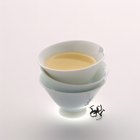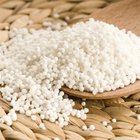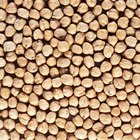vikif/iStock/GettyImages
Cornstarch, a gluten-free product made from dried and ground corn endosperm, has twice the thickening ability of flour and a neutral flavor when cooked. It's simple to use and fairly predictable, but it has a few limitations. It breaks down if you overcook or freeze it, and it must be added to cold liquids, not hot. In some situations, other thickeners, including flour, tapioca and arrowroot, are better choices.
For Custards and Pies
Cornstarch is the most common thickener used in custards, puddings and pie fillings; it's inexpensive, reliable and produces a thick, stable product. The two best substitutes for cornstarch for these types of desserts are arrowroot and tapioca, two thickeners that are made from roots. They thicken well, but they don't have the grainy taste associated with flour or cornstarch. They also give a glossy, translucent look, rather than an opaque, matte finish. Substitute arrowroot at a ratio of 1-part arrowroot for 1-part cornstarch. To use tapioca, substitute 2-parts tapioca for every 1-part cornstarch.
Thickening Gravy, Sauces and Stews
If you're making a savory dish that requires you to add the thickener at the beginning of the cooking time, use flour instead of cornstarch. Root thickeners don't hold up to long cooking times, so flour is the best choice. Use all-purpose white flour -- not bread, cake or whole-wheat flour -- at a rate of 2-parts flour for every 1-part cornstarch.
A Slurry or a Roux
You must choose the right thickening agent for the job, but you also have to add it at the right time and in the right way. If you're thickening a gravy or white sauce, use a roux, which you create by melting a bit of fat, such as butter, in a pan. Sprinkle the flour over the fat and whisk it in. Cook the flour and butter, whisking constantly for a few minutes, or until the flour browns slightly. The cooking helps eliminate a raw flour taste. Pour in heated milk, broth or other liquid and simmer, stirring constantly until the sauce thickens. A slurry is the preferred method for adding cornstarch and root-based thickeners to a dessert or sauce. Whisk together cold liquid and the thickening agent in a bowl before adding it to a hot sauce. In pudding and custard recipes, combine the thickener with eggs or cold milk. To make a fruit pie filling, the thickener is often combined with sugar and fruit, rather than liquid. As the pie bakes, the juices in the fruit combine with the thickening agent.
Stir-Fries
Cornstarch is often used in Asian cooking to prepare chicken for cooking -- a process known as "velveting" -- or as a coating for tempura. The thickener is also used widely to thicken sauces. For velveting, there really is no substitute for cornstarch, but water chestnut flour or powder is often used as a breading. Available in Asian markets, it gives a warm, nutty flavor to breaded, fried dishes. Substitute arrowroot or tapioca as a thickener for sauces. Substitute 1-part arrowroot or 2-parts tapioca for the cornstarch.
Related Articles

Substitute for Vanilla Custard Powder
Can You Substitute Cornstarch for Flour?

Can You Use Konjac Flour in Baking?

How to Make French Sauce With Roux of ...

How to Substitute Cornstarch for ...

How to Use Cornstarch to Make Breaded ...

How to Substitute Cornstarch for ...

How to Cook Luglug Cornstarch Noodles

Adding Corn Starch to a Pot Roast

Does Cornstarch Make Fried Chicken ...

What Can I Substitute for Cornstarch?

How to Thicken Stew With Flour
How to Use Arrowroot to Thicken a Fruit ...

What Is the Nutritional Value of ...

Can You Use Matzo Flour to Thicken ...

How to Cook Tapioca Balls

What Is Ratio for Cornstarch & Water to ...

Can I Coat Chicken Wings in Cornstarch ...

How to Roast Chickpea Flour

Can You Use Flour to Thicken Chili?
References
Writer Bio
Julie Christensen is a food writer, caterer, and mom-chef. She's the creator of MarmaladeMom.org, dedicated to family fun and delicious food, and released a book titled "More Than Pot Roast: Fast, Fresh Slow Cooker Recipes."